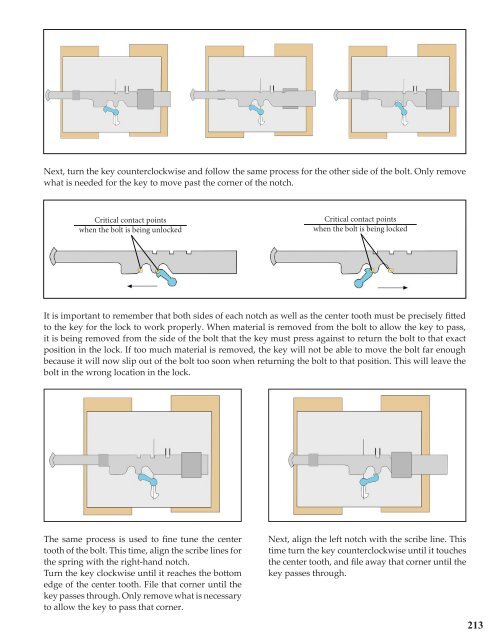The New Spruce Forge Manual of Locksmithing: A Blacksmith’s Guide to Simple Lock Mechanisms
The New Spruce Forge Manual of Locksmithing: a Blacksmith’s Guide to Simple Lock Mechanisms is a totally revised and expanded version of the original work from 1999. This new hardcover edition, at 304 pages and with more than 800 color photos and illustrations, is more than double the size of the original manual. It is divided into two distinct sections: Technical Information - This section is a reference manual in itself that covers the specific tools and techniques needed to build all the parts for each lock, as well as providing the information needed to understand the assembly instructions outlined in the second section. The Locks: Patterns & Instructions - This section provides the plans and detailed instructions for each of the 14 lock projects in this new edition. The clear assembly instructions describe when and how to use the technical information provided in section one. The authors have maintained their original trademark style that relies on well-illustrated step-by-step instructions that guide you through the whole lock-making process. They have also kept their low-tech approach that demonstrates how to go about creating good work using only a handful of simple tools. Making blacksmith locks is an age-old skill the authors of this manual are helping to preserve by passing on their knowledge to this book’s readers. The New Spruce Forge Manual of Locksmithing is also an excellent introduction to benchwork, which is a useful skill for any blacksmith to acquire. This manual will become a valuable, trusted and often referred to sourcebook in your blacksmithing library. Hardcover, 304 pages, more than 800 photos and illustrations.
The New Spruce Forge Manual of Locksmithing: a Blacksmith’s Guide to Simple Lock Mechanisms is a totally revised and expanded version of the original work from 1999. This new hardcover edition, at 304 pages and with more than 800 color photos and illustrations, is more than double the size of the original manual.
It is divided into two distinct sections:
Technical Information - This section is a reference manual in itself that covers the specific tools and techniques needed to build all the parts for each lock, as well as providing the information needed to understand the assembly instructions outlined in the second section.
The Locks: Patterns & Instructions - This section provides the plans and detailed instructions for each of the 14 lock projects in this new edition. The clear assembly instructions describe when and how to use the technical information provided in section one.
The authors have maintained their original trademark style that relies on well-illustrated step-by-step instructions that guide you through the whole lock-making process. They have also kept their low-tech approach that demonstrates how to go about creating good work using only a handful of simple tools.
Making blacksmith locks is an age-old skill the authors of this manual are helping to preserve by passing on their knowledge to this book’s readers. The New Spruce Forge Manual of Locksmithing is also an excellent introduction to benchwork, which is a useful skill for any blacksmith to acquire. This manual will become a valuable, trusted and often referred to sourcebook in your blacksmithing library.
Hardcover, 304 pages, more than 800 photos and illustrations.
You also want an ePaper? Increase the reach of your titles
YUMPU automatically turns print PDFs into web optimized ePapers that Google loves.
Next, turn the key counterclockwise and follow the same process for the other side <strong>of</strong> the bolt. Only remove<br />
what is needed for the key <strong>to</strong> move past the corner <strong>of</strong> the notch.<br />
Critical contact points<br />
when the bolt is being unlocked<br />
Critical contact points<br />
when the bolt is being locked<br />
It is important <strong>to</strong> remember that both sides <strong>of</strong> each notch as well as the center <strong>to</strong>oth must be precisely fitted<br />
<strong>to</strong> the key for the lock <strong>to</strong> work properly. When material is removed from the bolt <strong>to</strong> allow the key <strong>to</strong> pass,<br />
it is being removed from the side <strong>of</strong> the bolt that the key must press against <strong>to</strong> return the bolt <strong>to</strong> that exact<br />
position in the lock. If <strong>to</strong>o much material is removed, the key will not be able <strong>to</strong> move the bolt far enough<br />
because it will now slip out <strong>of</strong> the bolt <strong>to</strong>o soon when returning the bolt <strong>to</strong> that position. This will leave the<br />
bolt in the wrong location in the lock.<br />
<strong>The</strong> same process is used <strong>to</strong> fine tune the center<br />
<strong>to</strong>oth <strong>of</strong> the bolt. This time, align the scribe lines for<br />
the spring with the right-hand notch.<br />
Turn the key clockwise until it reaches the bot<strong>to</strong>m<br />
edge <strong>of</strong> the center <strong>to</strong>oth. File that corner until the<br />
key passes through. Only remove what is necessary<br />
<strong>to</strong> allow the key <strong>to</strong> pass that corner.<br />
Next, align the left notch with the scribe line. This<br />
time turn the key counterclockwise until it <strong>to</strong>uches<br />
the center <strong>to</strong>oth, and file away that corner until the<br />
key passes through.<br />
213










